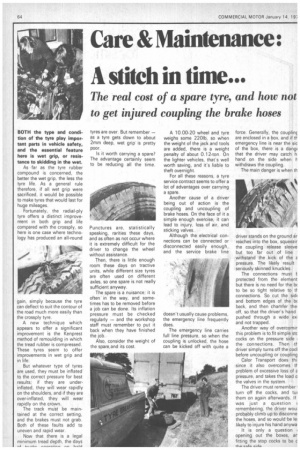Care & Maintenance A stitch in time...
Page 66

If you've noticed an error in this article please click here to report it so we can fix it.
The real cost of a spare tyre, and how not to get injured coupling the brake hoses
BOTH the type and condition of the tyre play important parts in vehicle safety, and the essential feature here is wet grip, or resistance to skidding in the wet.
As far as the tyre rubber compound is concerned, the better the wet grip, the less the tyre life. As a general rule therefore, if all wet grip were sacrificed, it would be possible to make tyres that would last for huge mileages.
Fortunately, the radial-ply tyre offers a distinct improvement in both grip and life compared with the crossply, so here is one case where technology has produced an all-round gain, simply because the tyre can deflect to suit the contour of the road much more easily than the crossply tyre.
A new technique which appears to offer a significant improvement is the Kenprest method of remoulding in which the tread rubber is compressed. These tyres seem to offer improvements in wet grip and in life.
But whatever type of tyres are used, they must be inflated to the correct pressure for best results; if they are under inflated, they will wear rapidly on the shoulders, and if they are over-inflated, they will wear rapidly on the crown.
The track must be maintained at the correct setting, and the brakes must not grab. Both of these faults add to uneven and rapid wear.
Now that there is a legal minimum tread depth, the days tyres are over. But remember — as a tyre gets down to about 2rnm deep, wet grip is pretty poor.
Is it worth carrying a spare? The advantage certainly seem to be reducing all the time.
Punctures are, statistically speaking, rarities these days, and as often as not occur where it is extremely difficult for the driver to change the wheel without assistance.
Then, there is little enough room these days on tractive units, while different size tyres are often used on different axles, so one spare is not really sufficient anyway.
The spare is a nuisance; it is often in the way, and some times has to be removed before a job can be done. Its inflation pressure must be checked regularly — and the workshop staff must remember to put it back when they have finished the job.
Also, consider the weight of the spare,and its cost. A 10.00-20 wheel and tyre weighs some 220Ib, so when the weight of the jack and tools are added, there is a weight penalty of about 0.12-ton. On the lighter vehicles, that's well worth saving, and it's liable to theft overnight For all these reasons, a tyre service contract seems to offer a lot of advantages over carrying a spare.
Another cause of a driver being out of action is the coupling and uncoupling of brake hoses. On the face of it a simple enough exercise, it can lead to injury, loss of air, and sticking valves.
Although the electrical connections can be connected or disconnected easily enough, and the service brake line doesn't usually cause problems, the emergency line frequently does.
The emergency line carries full line pressure, so when the coupling is unlocked, the hose can be kicked off with quite a
force. Generally, the couplinc are enclosed in a box, and if t1. emergency line is near the sic of the box, there is a dangi that the driver may catch h hand on the side when f' withdraws the coupling.
The main danger is when th
driver stands on the ground ar reaches into the box, squeezir the coupling release sleeve but too far out of line withstand the kick of the E pressure. The likely result seriously skinned knuckles.
The connections must E protected from the element but there is no need for the ix to be so tight relative to tf connections. So cut the sidi and bottom edges of the bc back, and then chamfer the' off, so that the driver's hand pushed through a wide exi and not trapped.
Another way of overcomir this problem is to fit simple sic cocks on the pressure side the connections. Then .tE driver simply turns off the codl before uncoupling or coupling
Calor Transport does thi since it also overcomes Vproblem of excessive loss of a pressure, and takes the load the valves in the system.
The driver must remember turn off the cocks, and tut them on again afterwards. If was just a question ( remembering, the driver woui probably climb up to disconne the hoses, and so would be le: likely to injure his hand anywa It is only a question I opening out the boxes, ar fitting the stop cocks to be c
thccafa cirla








































































































